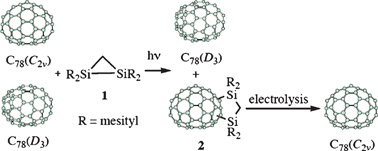A new method for separating the D3 and C2v isomers of C78†
Abstract
A new chemical method has been applied to isolate isomers of C78. The photochemical

* Corresponding authors
a College of Chemistry and Life Science, Shenyang Normal University, 253 Norther Huanghe Street, Huanggu District, Shenyang, China
b Center for Tsukuba Advanced Research Alliance, University of Tsukuba, Tsukuba, Japan
c Institute of Multidisciplinary Research for Advanced Materials, Tohoku University, Sendai, Japan
d Japan Nuclear Fuel Cycle Development Institute, Tokai, Japan
e Department of Applied Physics and Chemistry, The University of Electro-Communications, Chofu, Japan
f Department of Theoretical Studies, Institute for Molecular Science, Okazaki, Japan
A new chemical method has been applied to isolate isomers of C78. The photochemical

 Please wait while we load your content...
Something went wrong. Try again?
Please wait while we load your content...
Something went wrong. Try again?
A. H. Han, T. Wakahara, Y. Maeda, T. Akasaka, M. Fujitska, O. Ito, K. Yamamoto, M. Kako, K. Kobayashi and S. Nagase, New J. Chem., 2009, 33, 497 DOI: 10.1039/B808119K
To request permission to reproduce material from this article, please go to the Copyright Clearance Center request page.
If you are an author contributing to an RSC publication, you do not need to request permission provided correct acknowledgement is given.
If you are the author of this article, you do not need to request permission to reproduce figures and diagrams provided correct acknowledgement is given. If you want to reproduce the whole article in a third-party publication (excluding your thesis/dissertation for which permission is not required) please go to the Copyright Clearance Center request page.
Read more about how to correctly acknowledge RSC content.
 Fetching data from CrossRef.
Fetching data from CrossRef.
This may take some time to load.
Loading related content
